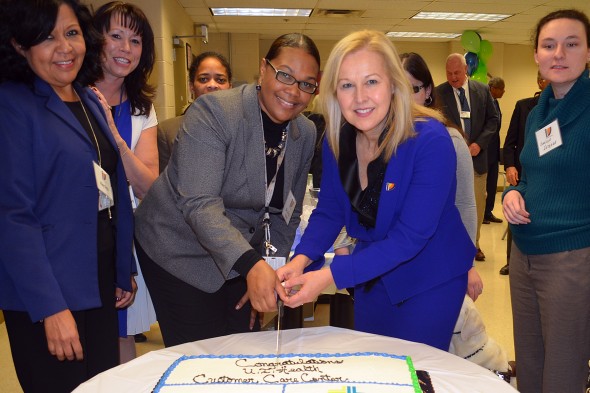UI Health call center expands with Chicago Lighthouse

Airica Steed of UI Health and Janet Szlyk of Chicago Lighthouse celebrate a partnership that will expand the UI Health call center with Lighthouse employees.
Callers to UI Health’s customer call center can expect prompter and more consumer-oriented service thanks to a new partnership with the Chicago Lighthouse.
The Customer CARE Center added new employees of the Lighthouse, a nonprofit agency that provides employment, education and other services to people with disabilities, including visual impairments.
UI Health and the Chicago Lighthouse celebrated the new partnership at a ribbon-cutting ceremony Nov. 19 at the Lighthouse, 1850 W. Roosevelt Road.
The newly expanded Customer CARE Center provides general information, scheduling and coordinating of patient appointments, referrals and pre-registration, appointment reminders and connections to nurses who can answer health questions.
“This new partnership will help widen the door to UI Health by improving access to care through the Customer CARE Center while enabling us to continue to provide the exceptional customer-centered experience we are known for,” said Airica Steed, chief experience officer at UI Health.
“Our call volume has increased more than 40 percent in the past year,” said Mary Ann Hodgers, the call center’s assistant director of quality improvement. “Expanding our capacity to answer more calls in a timely manner will help us improve satisfaction for our patients and callers.”
The Chicago Lighthouse has more than 600 employees working for a variety of clients. About 300 answer customer service calls for the Illinois Tollway at a call center in Student Center East.
“Our employees have a very good reputation for providing excellent customer service at a number of call centers, and we are very excited about this new partnership with UI Health’s customer service center,” said Janet Szlyk, Lighthouse executive director.
“All of The Lighthouse employees who are answering calls for UI Health use software that allows for text-to-speech translation, so employees who are blind or have very low vision can have the software read aloud text on their screen.”
People with visual impairments or who are blind have exceptionally high levels of unemployment compared to the general population. About 75 percent of the estimated 4 million adults in the U.S. who are completely or partially blind are not in the labor force.
